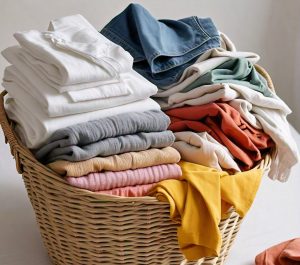Drying clothes in the microwave refers to the method of using a microwave oven, typically used for heating or cooking food, to dry wet garments.
The question here is whether it’s safe and effective to use microwave for such a purpose.
This article will delve into the subject of drying clothes in microwaves, exploring if it’s indeed possible or advisable. It’ll discuss critical facts surrounding microwaving textiles, including potential risks and how it may affect fabric quality. If deemed feasible, we’ll provide guidelines on how long you should do so without causing damage; if not, alternatives to conventional drying means will be suggested along with safety tips and precautions when using unconventional methods like these. FAQs and concluding remarks about this unusual topic will also be shared.

Jump To:
Can You Dry Clothes in the Microwave?
No, you cannot dry clothes in the microwave. Microwaves work by heating water molecules which can lead to overheating and potentially cause a fire if applied to materials like fabric. It is safer and more effective to use traditional methods for drying clothes such as air-drying or using a tumble dryer. Other options include heat pumps and condenser dryers, both designed specifically for this purpose. Using a microwave to dry clothes is not advisable due to the risk of damage or safety hazards.
Check out if you can heat a wet towel in the microwave.
Facts About Drying Clothes in the Microwave
Here, we will discuss the important things to note about drying clothes in a microwave.
- Potential Damage: Microwaving clothes can potentially damage both the clothes and the microwave. This is because microwaves heat items by agitating water molecules which may not be good for all clothing materials.
- Safety Risks: There can be safety risks involved if unsuitable materials are microwaved as they can cause fire hazards.
- Inefficiency: Clothing articles with high absorption capacity like towels might take longer time compared to conventional drying methods due to their thickness and density.
- Metal Elements: Any clothing item with metal parts should never be put inside a microwave as it could spark and start a fire.
We have now covered some important factors regarding microwaving clothes.
Next, we will discuss other aspects related to microwaving different types of textiles or fabrics.
What are the Alternatives to Microwaving Clothes?
An alternative to drying clothes in a microwave is using traditional methods such as air-drying, machine-drying, or sun-drying. Air-drying can be done indoors or outdoors and is a gentle method that maintains fabric integrity. Machine drying, on the other hand, uses heat and tumble action for quick results but may cause shrinkage and damage. Sun-drying is eco-friendly and naturally sanitizes your garments due to ultraviolet radiation.
Check out if you can put a wet rag in the microwave.
Tips to Microwave Clothes
- Ensure your clothing item isn’t metallic or has any metal attachments, as these could spark in the microwave.
- If you decide to use a microwave for small items like socks or underwear ensure it’s clean of food debris which can transfer unwanted odors onto clothes.
- Always wet the garment first before putting it into the microwave since dry materials have a higher chance of catching fire.
- Microwave each piece separately so that heat distributes evenly among all areas of an individual piece instead of bundled pieces where some areas might be left damp while others get overheated.
- Avoid leaving garments inside for long periods – typically 30 seconds should suffice but keep an eye throughout the heating process to prevent overheating which could lead to burning risks.
We’ve now discussed how rather than microwaving garments, there exist various safer alternatives. Plus, tips if one chooses this unconventional approach.
Check out if you can microwave a paper towel.
In our upcoming FAQs section, we will delve deeper into various aspects surrounding this topic further enriching our understanding of this subject matter.

Frequently Asked Questions (FAQs)
In this section, we will now look at the most commonly asked questions related to microwaving and heating. We aim to provide clear and concise answers that can help guide your use of your microwave safely and effectively.
Can you dry clothes in the microwave?
No, it’s not advisable to dry clothes in a microwave. Microwaves work by heating water molecules, which could result in uneven drying or even scorching of fabric. Use a dryer or air-drying method for safe and effective cloth drying instead.
Can you heat food without a cover?
Yes, but heating food without covering can lead to a mess as some foods may splatter due to intense heat. It’s recommended to lightly cover dishes with a suitable microwave-safe lid or wrap for better heat distribution and cleanliness.
Is it safe to put plastic containers in the Microwave?
Certain plastics can potentially leak harmful chemicals when heated so it is generally advised not to use them. However, if marked as ‘microwave-safe’, they are made from materials designed specifically for microwaving – these are fine for use.
Can metal be used inside the microwave?
No! Metal objects reflect microwaves which can cause sparks leading to potentially hazardous situations such as fire hazards. Always remove any metal packaging before using your device!
This concludes our frequently asked questions section on microwaving and heating items within a household setting.
Final Word
Microwave ovens are indeed handy appliances providing efficiency and convenience but there are certain precautions that need to be taken when using one to avoid accidents and potential harm. Understanding what kinds of materials should go into a microwave is crucial.



